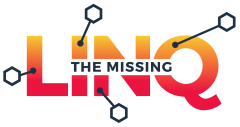Filtering down sites based on quality will save significant time and improve a link building campaign’s impact.
This painful fact is because:
- Link building is time-consuming, and narrowing down sites by quality metrics or criteria can ensure the hours spent on link building are focused on the sites that will have the highest impact, and
- Google’s algorithm uses a site’s quality to identify how much value it will pass to the outbound link.
However, Google must overtly provide details about how its algorithm determines, and scores link quality.
This black box leaves us either using third-party tools and metrics or guessing how to evaluate a site’s quality from a manual review.
Using metrics or an on-site quality evaluation can be called inherent link quality. This quality indicator is because the evaluation examines the site’s quality standards based on the characteristics of the site.
In contrast, earned and naturally built links have an inferred quality that assumes the link passes value because it doesn’t violate Google’s link spam guidelines.
This article introduces a new framework to evaluate the quality of prospective domains for link building.
Understanding Inferred Link Quality
John Mueller, Search Advocate for Google, explained in a Search off the Record podcast that the link building campaign that doesn’t violate Google’s guidelines are those that earn links.
Mueller suggests that create fantastic content and promoting it in paid ads, social, sharing in online communities, and performing PR that yields links because people want to share it.
I asked ChatGPT to act as John Mueller and recommend a link building technique that doesn’t violate Google’s link spam guidelines, and the results confirmed which technique to use.
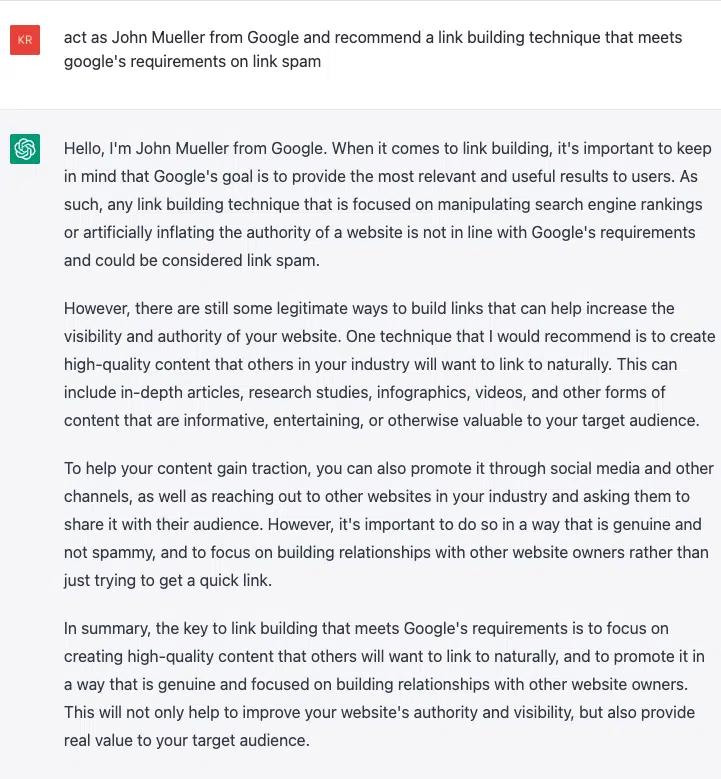
Inferred quality plays an essential role in link building. SEOs or digital marketers that want to comply with Google’s guidelines can use these link building techniques that infer quality:
Content marketing: Creating long-form content with a unique value, like in-depth articles and studies, then sharing it on social or sponsoring the content with online communities.
High-quality guest posting: an example is my guest post in Search Engine Land. This link was in the byline and went to the homepage of my site; and is a typical type of link, and the links in my articles never go to my own or my client’s sites.
Help a Reporter Out (HARO) pitching: HARO has a list of requests from journalists and bloggers for quotes or resources to include in their articles.
Skyscraper technique: This link building technique involves creating high-quality content that is better than existing content on a topic and then promoting it to attract links from other websites.
Important considerations when selecting to do an inferred link campaign:
- Scalability is questionable and less predictable with earning links. But a vigorous campaign can yield hundreds of high-quality links.
- Cost-effectiveness: The cost per link can be relatively high, costing thousands in content creation and distribution costs.
- Sustainability: These kinds of link campaigns ensure a site won’t get a penalty, manual action, or a devalued link profile.
- Dependence on external factors: Unlike paid link building, natural link building campaigns need more control over anchor text, destination URL, or context. These links will likely point to the homepage or informational articles when using descriptive anchor text.
- Topical & contextual relevance: The sites in these campaigns tend to be topically relevant by default, as these techniques focus on creating content and targeting a specific niche audience.
Understanding Inherent Link Quality
A site has quality characteristics that are inherent to the site’s link profile, content, and user experience. These can be identified with metrics using Ahrefs, Majestic, Moz, or custom tools.
These four tools have comparable metrics but use different methods to calculate their scores.
Metrics and characteristics of a site that contribute to an inherent quality
Many of these metrics have a strong correlation with first-page rankings. However, Google confirmed that they didn’t use an authority score in their ranking factors in 2016 and iterated again in an episode of Search off the Record that google doesn’t use third-party metrics in their score and that improving these metrics will not improve ranking.
Moz:
The domain and page-level metrics in moz help filter down sites for prospecting but can be misused for link building. According to Moz’s Authority Score white paper, using authority metrics to score a site is not helpful and instead should be compared against similar domains in a niche. This comparison should apply to all SEO metrics.
Moz uses its Dotbot crawler to collect domain and page-level data points and then feeds the data into a machine learning algorithm to calculate the scores below.
A study by Proficient Digital, moz has the largest link data set compared to Majestic, Ahrefs, and SEMrush. I didn’t expect that, as I remember when it was the smallest. The times they are a-changin’.
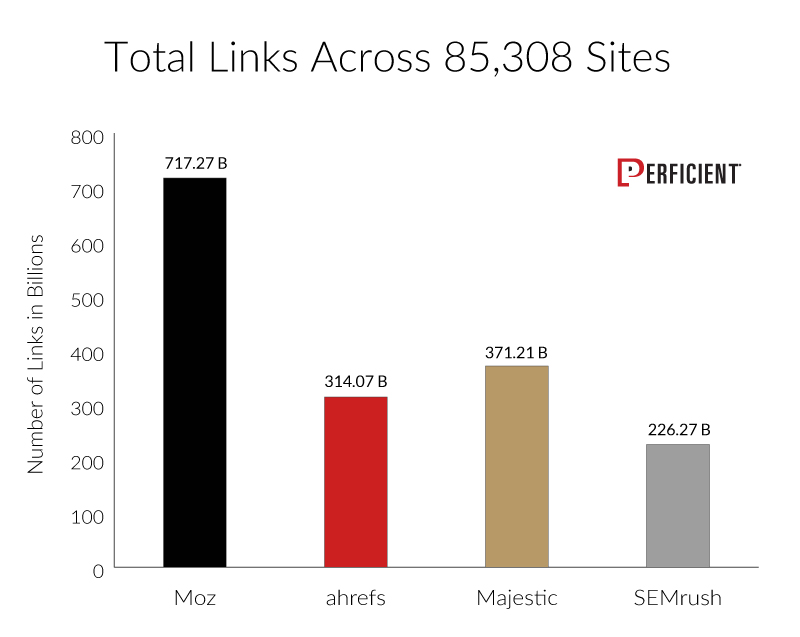
What are moz’s metrics?
- Domain Authority (DA): a domain-level score by Moz that is calculated based on a site’s link profile, among other factors. According to moz, this score correlates with a site’s ability to rank in search engines.
- Page Authority (PA): a page-level score to evaluate the likelihood of a page’s ability to rank. It is calculated the same way as DA, with more than 40 factors contributing to the score.
- Spam score: a domain-level score to evaluate how spammy a site is, but a high spam score sometimes means the site is spammy. In my experience, this score isn’t that useful to determine if a site is valuable for link building.
Ahrefs
Despite the Proficient study, Ahrefs claims to have the world’s largest index of live backlinks. This metric is an aggregate of internal and external links.
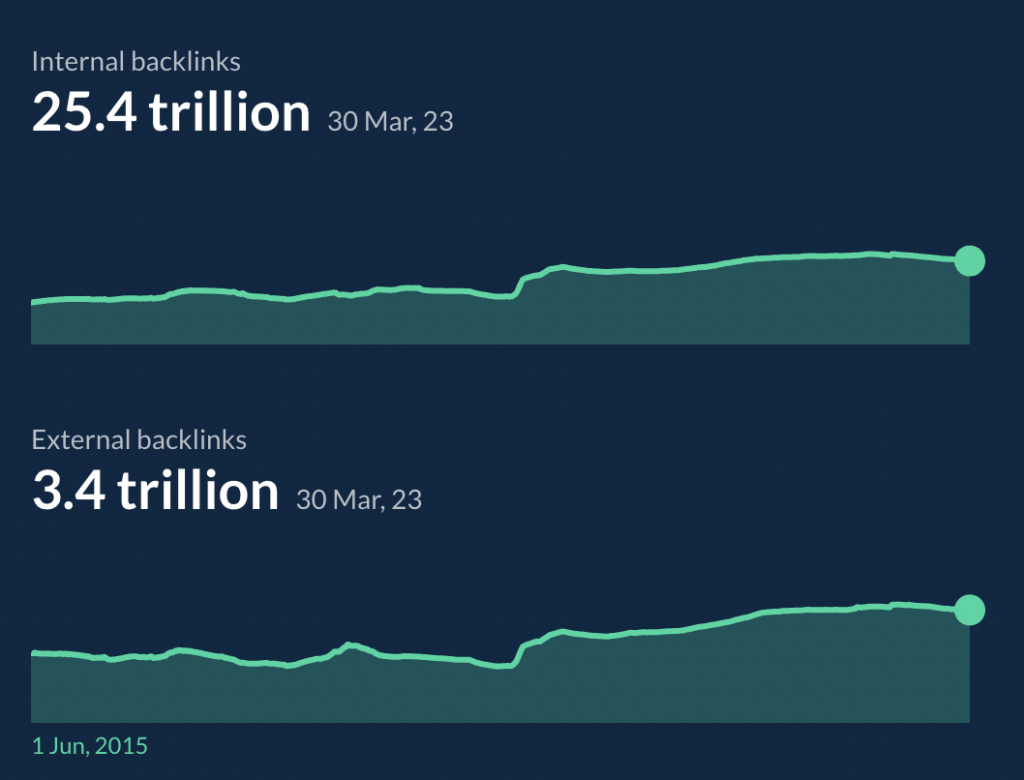
Does this impact the accuracy of the metrics? I don’t think so. You won’t compare one site’s DR to another’s DA. The data size means you should use one or the other as your primary solution for evaluating site quality.
Here are the primary metrics used in evaluating a site for link building.
- Domain Rating (DR): The score is a metric that represents the strength and authority of a website’s overall backlink profile.
- URL Rating (UR): Measures the strength of a target URL’s backlink profile on a logarithmic scale from 0 to 100. The score is based on the number and quality of the backlinks pointing to that URL. Ahrefs claims they use the “same basic PageRank principles to calculate URL rating.”
- Organic traffic: This metric calculates organic traffic based on the keywords’ search volume, position, and estimated click-through rate (CTR).
- Keywords count: This is a simple count of the keywords the site ranks for in Google.
Majestic
I have been using majestic for the majority of my SEO career. The tool uses flow metrics as its proprietary system to calculate site quality. But majestic is very topically focused. The suite of tools is comparable to Ahrefs, but majestic’s topical trust flow is a unique feature.
Majestic doesn’t publish the size of its link index but wrote this interesting article explaining why they think size doesn’t matter.
- Trust Flow (TF): Trust Flow measures how trustworthy a website appears based on the quality and quantity of links from other sites.
- Citation Flow (CF): The more links pointing to a URL, the higher the Citation Flow score will be. However, the score does not consider the links’ quality.
- Topical trust flow: Measures the quality and relevance of a website’s backlinks within a particular topic or niche.
- TF:CF ratio: The TF/CF ratio can indicate the overall quality of a website’s backlink profile. A high TF/CF ratio suggests that a website has a high proportion of quality backlinks compared to the total backlinks, which is generally considered a positive sign for SEO.
SEMrush
This tool is one of the big four. In 2021, the company published a study showing they had the largest “total backlinks” compared to Moz, Ahrefs, and Majestic.
I don’t know which database is more extensive, but each has some links that the others do not. And this doesn’t dismiss the value the scores have to evaluate site quality.
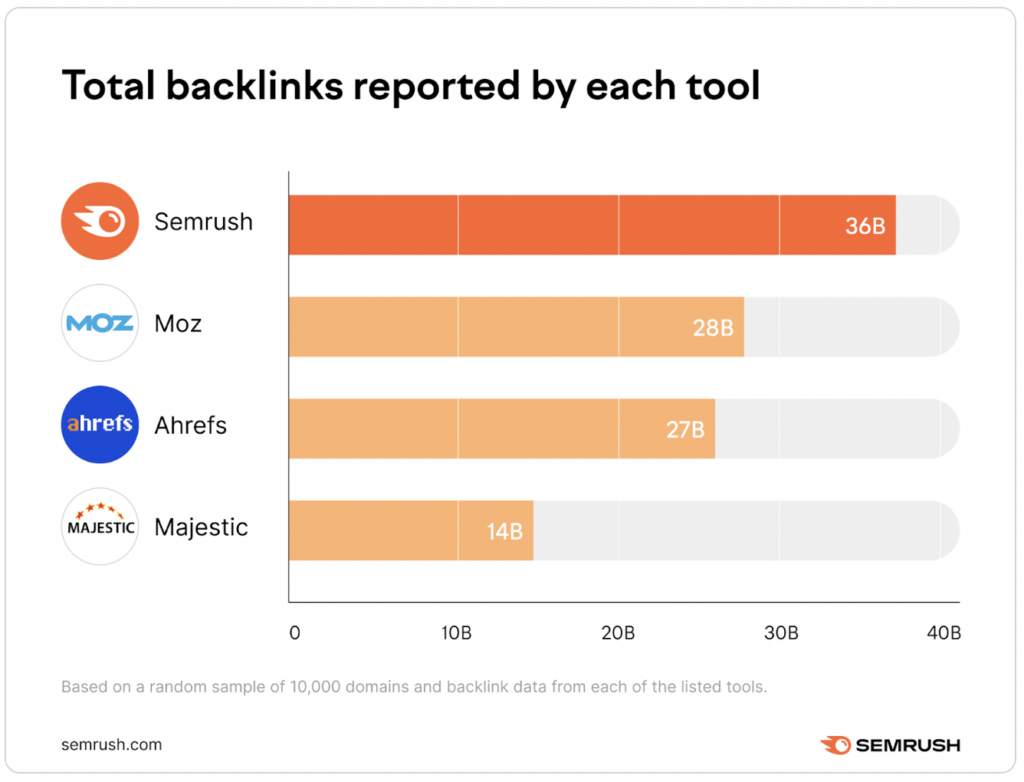
- Authority Score: measures the overall quality and trustworthiness of a website’s backlink profile, taking into account various factors, such as the number and quality of referring domains, the anchor text used in backlinks, and the diversity of the backlink profile.
- Organic traffic: This data is calculated by analyzing search engine results pages (SERPs) for the website’s target keywords.
Considerations when using metrics to evaluate site quality:
- Not used by Google: Google has confirmed that it doesn’t use these metrics and states not to use an authority score for a domain.
- Correlation, not causation: The tools use machine learning to analyze dozens, if not hundreds, of variables to calculate the score, which is why higher domain authority metrics correlate with first-page rankings. However, increasing these metrics alone will not translate to a higher ranking.
- Scalability: Using these metrics to filter down lists of sites to focus efforts on a few targeted domains or help build large lists of sites for outreach. These metrics can also be used in paid link building, which is much more scalable than organic outreach but has some risks.
- Time and resource investment: Manual review of a site can take 5 minutes per side, but these metrics can reduce the review time to a few sites every minute.
How to determine whether to use inferred v. inherent link quality?
These methods to evaluate site quality can be used in tandem, but specific techniques & scenarios will not require you to use metrics, and others will make them necessary.
When to use :
- Use metrics when
- Evaluating the performance of a link building campaign compared to similar sites in a niche.
- Narrowing down a list of sites for guest posting outreach.
- Determining to pursue paid placement opportunities.
- When inferred quality techniques are enough
- When focused on a niche that typically has low-authority sites, then topical relevancy is more important than metrics.
- If you are targeting publications for guest posting based on their audience
Conclusion
The success of a link building campaign is highly dependent on the quality and topical relevancy of the sites targeted for link acquisition. By focusing on campaigns that require both inherent and inferred link quality, digital marketers and SEO professionals can significantly improve the impact of their link building efforts. While Google does not overtly provide details about its algorithm or utilize third-party metrics, these metrics can still serve as valuable indicators for site evaluation.
Inferred link quality emphasizes earning links through high-quality content creation, targeted outreach, and compliance with Google’s guidelines. Inherent link quality, on the other hand, relies on third-party tools and metrics to evaluate a site based on its link profile, content, and user experience.
Ultimately, link building requires a thoughtful approach to building strategies that incorporate both inferred and inherent link quality will lead digital marketers to more effective and sustainable link building campaigns.
